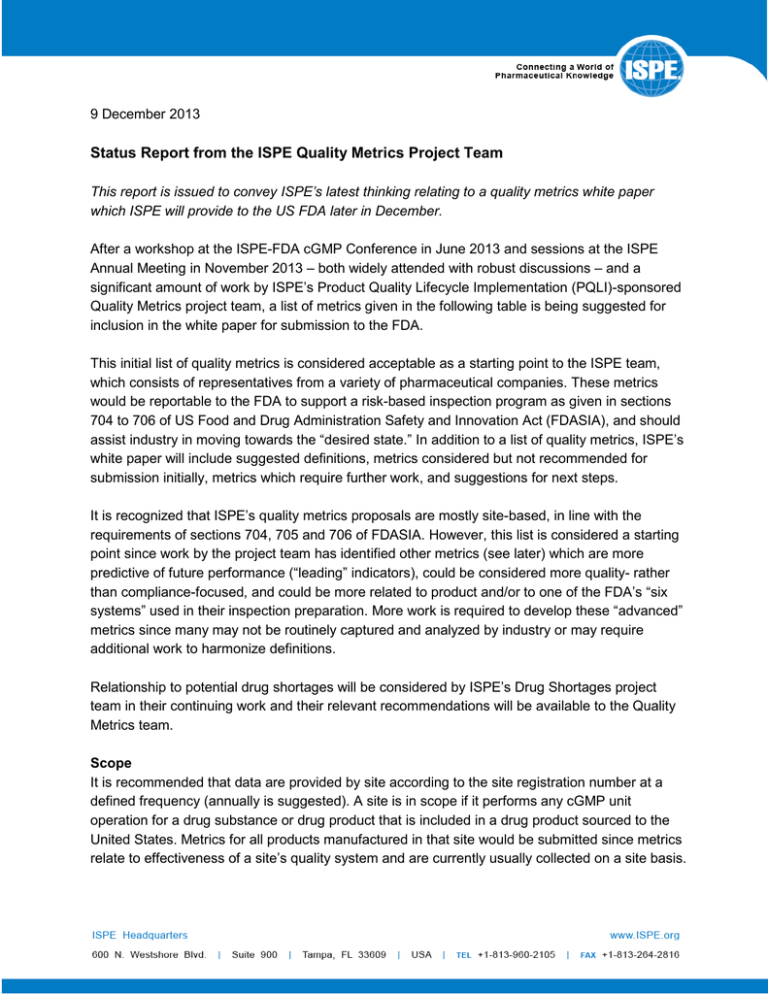Status Report from the ISPE Quality Metrics Project Team
advertisement

9 December 2013 Status Report from the ISPE Quality Metrics Project Team This report is issued to convey ISPE’s latest thinking relating to a quality metrics white paper which ISPE will provide to the US FDA later in December. After a workshop at the ISPE-FDA cGMP Conference in June 2013 and sessions at the ISPE Annual Meeting in November 2013 – both widely attended with robust discussions – and a significant amount of work by ISPE’s Product Quality Lifecycle Implementation (PQLI)-sponsored Quality Metrics project team, a list of metrics given in the following table is being suggested for inclusion in the white paper for submission to the FDA. This initial list of quality metrics is considered acceptable as a starting point to the ISPE team, which consists of representatives from a variety of pharmaceutical companies. These metrics would be reportable to the FDA to support a risk-based inspection program as given in sections 704 to 706 of US Food and Drug Administration Safety and Innovation Act (FDASIA), and should assist industry in moving towards the “desired state.” In addition to a list of quality metrics, ISPE’s white paper will include suggested definitions, metrics considered but not recommended for submission initially, metrics which require further work, and suggestions for next steps. It is recognized that ISPE’s quality metrics proposals are mostly site-based, in line with the requirements of sections 704, 705 and 706 of FDASIA. However, this list is considered a starting point since work by the project team has identified other metrics (see later) which are more predictive of future performance (“leading” indicators), could be considered more quality- rather than compliance-focused, and could be more related to product and/or to one of the FDA’s “six systems” used in their inspection preparation. More work is required to develop these “advanced” metrics since many may not be routinely captured and analyzed by industry or may require additional work to harmonize definitions. Relationship to potential drug shortages will be considered by ISPE’s Drug Shortages project team in their continuing work and their relevant recommendations will be available to the Quality Metrics team. Scope It is recommended that data are provided by site according to the site registration number at a defined frequency (annually is suggested). A site is in scope if it performs any cGMP unit operation for a drug substance or drug product that is included in a drug product sourced to the United States. Metrics for all products manufactured in that site would be submitted since metrics relate to effectiveness of a site’s quality system and are currently usually collected on a site basis. It is not recommended that recalls, field alert reports (FARs), biological product deviation reports (BPDRs) and inspection findings are reported to the FDA as part of this list since these are already available to the FDA. Proposed Metrics and Relationship to the FDA’s “six systems” Proposed Metric Batch Rejection Rate Strongest Relationship to a FDA ‘six system’ Production, Packaging & Labelling Strong Leading or Lagging Indicator Lagging Relationship to Product Rework and Reprocessing rate Production Strong Lagging Confirmed out of specification (OOS) rate Production Strong Lagging Unconfirmed OOS rate Laboratory Weak Lagging Confirmed “Critical” Complaints Rate Quality Strong Lagging % Annual Product Quality Reviews Completed on time Quality Medium Lagging * From a survey at the ISPE June 2013 meeting Rationale and Comments Already collected by about 95%* of companies in some form. A measure of production quality or packaging and labelling quality. These are not normally collected as a quality metric, but may be captured as a financial metric or as part of Annual Product Review. This metric is proposed as a corollary to the Batch Rejection Rate to provide a fuller picture of the production capability. Number of OOS is tracked by most companies*. Would expect that batches that are OOS would end up being included in ‘Batch Rejection Rate’ metric. Useful sub-division of Batch Rejection Rate. A measure of production quality. A measure of laboratory quality and potentially has a link to the quality system Strong link to product quality and quality system performance. May overlap with Field Alerts or other Health Authority reporting. Suggest Definition comes from Field Alert CFR definition High and consistent values are a leading indicator of a quality system performance. Productbased metric with strong links to quality system performance. A substantial amount of work by the ISPE Quality Metrics project tea and its sub teams, and feedback from public debate has shown that: • Metric data often exist in different databases even within the same company and are difficult to collect, summarize and submit. • Definitions of metrics chosen need to be extremely well established so that data are consistently generated. • When metrics’ submission is implemented by the FDA, ISPE project team members would like to remain openly engaged with the FDA regarding their intentions and experiences in processing these new data. • It is recommended that all the FDA registered firms and sites report annually to the FDA by the end of February each calendar year. This would allow time for firms to collect, analyze and understand the data. The report would be against the site registration or DUNS number. • Industry would provide both the raw data (numerator and denominator) as well as the rate for the proposed metric, so that perspective on the facility may be provided. For example, a drug substance site manufacturing only a few batches could be identified with this information. It is not proposed to submit what products are registered by site, since the FDA should already have that information. • Industry members also would welcome working with the FDA to modify or develop new algorithms to analyze data, and companies would welcome feedback to provide them with a view of their performance. • The ISPE Quality Metrics project team will continue to collaborate with the ISPE Drug Shortages work stream to consider potential metrics useful to assist with predicting drug shortages Significant work has shown that even more work is required to develop consistent, easy-to-collect, meaningful leading indicator metrics, so called “advanced” metrics. Metrics under the themes Quality Culture, Quality System Effectiveness, and Process Capability are actively under consideration, for example: – Repeat deviations – Corrective action, preventive action (CAPA) effectiveness – Training effectiveness – Quality Culture – Facility re-investment or recapitalization – Process capability – Right First Time The project team will continue to evaluate these activities for future progress. Examples of challenges faced by the team are: • Right First Time is measured by about two-thirds of the companies who were present at the June meeting, however, there are wide variations in definitions and scopes between companies • • % GMP training on time was strongly considered, however, it is thought more worthwhile to develop other leading quality culture metrics Process capability has good potential as a leading metric, however, much further work is required to develop definitions across many possible statistical tools and for companies to implement since this type of metric appears not to be commonly applied, and where applied there are wide variations of definitions and approaches. Based upon the work conducted by ISPE’s Quality Metrics project team, it is proposed that a pilot program in cooperation with the FDA is conducted for a period to be decided in order to determine the following: • to examine the practicalities and the process of collecting, analyzing, evaluating and reporting the data, and the feedback loop mechanism to industry • to further “flush out” any definition discrepancies and understand the challenges of consistency in terminology/language • to develop how the data could be used beneficially by all parties, • to help decide on next steps for the extension of the program In conclusion, an initial list of metrics is suggested. Further work is recommended to address challenges of implementation and develop “advanced” metrics and associated algorithm that assist industry move towards the “desired state.”





